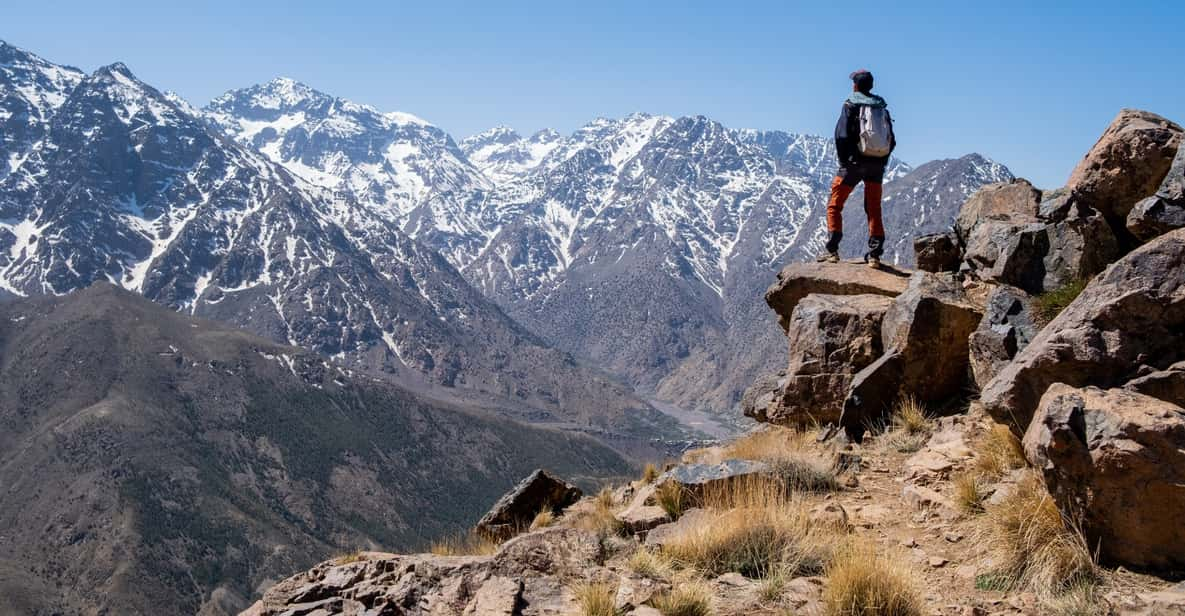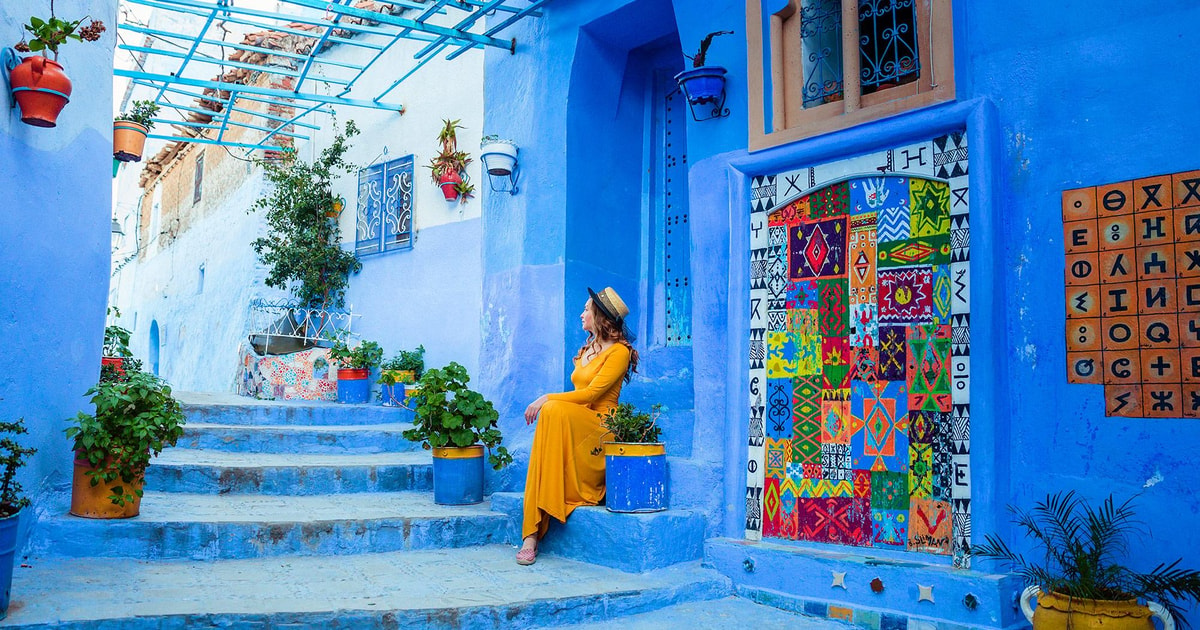
Atlas Mountains Hiking Guide: Complete Trekking Routes from Marrakech (2025)
Ultimate Atlas Mountains hiking guide with detailed trekking routes, Mount Toubkal ascent, Berber villages, best seasons, and complete preparation tips for Morocco mountain adventures.
Atlas Mountains Hiking Guide: Morocco's Ultimate Trekking Adventure
The Atlas Mountains stretch across Morocco like a magnificent backbone, offering some of Africa's most spectacular hiking and trekking opportunities. From day hikes through Berber villages to challenging multi-day treks to North Africa's highest peak, the Atlas Mountains provide unforgettable adventures just hours from Marrakech.
Atlas Mountains Overview
Mountain Ranges
The Atlas Mountains consist of three main ranges:
High Atlas (Haut Atlas):
- Highest peaks: Mount Toubkal (4,167m), Mount Ouanoukrim (4,089m)
- Best for: Serious trekking, mountain climbing, challenging hikes
- Distance from Marrakech: 60-100km
- Highlights: Toubkal National Park, Imlil village, dramatic peaks
Middle Atlas (Moyen Atlas):
- Characteristics: Cedar forests, lakes, gentler terrain
- Best for: Nature walks, wildlife watching, family hikes
- Distance from Marrakech: 200-300km
- Highlights: Azrou cedar forest, Ifrane, Barbary macaques
Anti-Atlas:
- Features: Desert mountains, unique geology, ancient villages
- Best for: Cultural trekking, desert-mountain combination
- Distance from Marrakech: 200-400km
- Highlights: Tafraoute, Ameln Valley, prehistoric rock art
Best Atlas Mountains Hiking Destinations
1. Mount Toubkal Trek (4,167m)
Difficulty: Challenging
Duration: 2-3 days
Best season: April-October
Starting point: Imlil village (1,740m)
Day 1: Imlil to Toubkal Refuge
- Distance: 5km
- Duration: 3-4 hours
- Elevation gain: 1,000m
- Terrain: Rocky path, mule tracks
- Accommodation: Mountain refuge (3,207m)
Day 2: Summit Day
- Start: 4:00 AM for sunrise summit
- Duration: 4-5 hours to summit, 3 hours descent
- Difficulty: Steep scree slopes, some scrambling
- Views: Panoramic Atlas Mountains, Sahara Desert glimpses
Day 3: Return to Imlil
- Duration: 3-4 hours descent
- Route: Via Armed village or direct path
- Celebration: Traditional Berber lunch in Imlil
What to Expect:
- Altitude challenges: Acclimatization needed above 3,000m
- Weather changes: Temperature drops significantly with altitude
- Basic facilities: Mountain refuge with dormitory-style accommodation
- Stunning views: 360-degree panoramas from North Africa's highest peak
2. Ourika Valley Hiking
Difficulty: Easy to moderate
Duration: Day trip or overnight
Best season: March-November
Starting point: Setti Fatma village
7 Waterfalls Hike:
- Distance: 3km round trip
- Duration: 2-3 hours
- Elevation gain: 300m
- Highlights: Series of cascading waterfalls, natural pools
Extended Ourika Trek:
- Duration: 2-3 days
- Route: Setti Fatma to Oukaimeden
- Difficulty: Moderate to challenging
- Accommodation: Berber villages, mountain gites
What to See:
- Traditional villages: Authentic Berber mountain communities
- Terraced agriculture: Ancient farming techniques
- Wildlife: Barbary macaques, various bird species
- Geology: Dramatic red rock formations
3. Imlil Valley Exploration
Difficulty: Easy to moderate
Duration: Day trips or multi-day treks
Base: Imlil village (1,740m)
Best for: Acclimatization, cultural immersion
Popular Day Hikes from Imlil:
Armed Village Circuit:
- Distance: 6km loop
- Duration: 3-4 hours
- Highlights: Traditional Berber village, mountain views
- Difficulty: Easy, suitable for families
Azzaden Valley:
- Distance: 8km one way
- Duration: Full day
- Highlights: Remote valley, traditional villages, waterfalls
- Difficulty: Moderate
Tacheddirt Village:
- Distance: 10km
- Duration: 5-6 hours
- Highlights: High-altitude village, stunning mountain panoramas
- Difficulty: Moderate to challenging
4. Ait Bougmez Valley (Happy Valley)
Difficulty: Easy to moderate
Duration: 2-5 days
Characteristics: Wide valley, traditional agriculture
Best for: Cultural trekking, photography
Valley Highlights:
- Traditional villages: Preserved Berber architecture
- Ancient granaries: Historic storage buildings
- Fossil discoveries: Geological significance
- Seasonal activities: Harvest participation, local festivals
Trekking Options:
- Valley floor walks: Easy terrain, cultural focus
- Ridge hikes: Moderate difficulty, panoramic views
- Multi-day circuits: Connecting multiple villages
Best Hiking Seasons
Spring (March-May)
Weather: Perfect temperatures (15-25°C), minimal rainfall
Pros: Ideal hiking conditions, wildflowers, clear mountain views
Cons: Popular season, advance booking recommended
Best for: All difficulty levels, photography, cultural tours
What to Expect:
- Snow-capped peaks with green valleys
- Blooming almond trees (February-March)
- Comfortable camping weather
- Excellent visibility for mountain photography
Summer (June-August)
Weather: Hot in valleys (25-35°C), pleasant at altitude
Pros: Long daylight hours, warm camping weather, all trails accessible
Cons: Very hot at lower elevations, crowded popular routes
Best for: High-altitude treks, early morning starts
Hiking Tips:
- Start very early (5-6 AM) to avoid midday heat
- Carry extra water and sun protection
- Focus on higher elevation routes
- Consider overnight treks to escape valley heat
Fall (September-November)
Weather: Excellent temperatures (18-28°C), stable conditions
Pros: Perfect hiking weather, fewer crowds, harvest season
Cons: Shorter daylight hours, some high passes may have early snow
Best for: All types of trekking, cultural experiences
Seasonal Highlights:
- Harvest activities in Berber villages
- Clear, crisp mountain air
- Excellent photography conditions
- Comfortable camping temperatures
Winter (December-February)
Weather: Cold temperatures (5-15°C), snow above 2,500m
Pros: Dramatic snow-capped scenery, fewer tourists, authentic experiences
Cons: Limited high-altitude access, cold camping, shorter days
Best for: Lower elevation hikes, cultural tours, photography
Winter Considerations:
- Mount Toubkal requires winter climbing experience
- Many high passes closed due to snow
- Essential to have proper winter gear
- Focus on valley walks and cultural experiences
Essential Hiking Gear
Clothing Layers
Base Layer:
- Moisture-wicking synthetic or merino wool
- Long-sleeve shirts for sun protection
- Lightweight hiking pants
Insulation Layer:
- Fleece or down jacket for altitude
- Warm hat and gloves
- Insulated pants for high altitude
Outer Layer:
- Waterproof/windproof jacket
- Rain pants for weather protection
- Gaiters for rocky terrain
Footwear
Hiking Boots:
- Sturdy, broken-in hiking boots
- Ankle support for rocky terrain
- Waterproof for stream crossings
Camp Shoes:
- Lightweight sandals or slip-ons
- For refuge/camp comfort
- Stream crossing backup
Technical Equipment
Navigation:
- Detailed topographic maps
- GPS device or smartphone with offline maps
- Compass and basic navigation skills
Safety Gear:
- First aid kit with altitude sickness medication
- Emergency whistle
- Headlamp with extra batteries
- Emergency shelter or bivy
Camping Gear (Multi-day treks):
- Four-season tent for mountain conditions
- Sleeping bag rated for expected temperatures
- Insulated sleeping pad
- Portable stove and cookware
Berber Culture and Villages
Traditional Mountain Life
Architecture:
- Stone and mud construction: Using local materials
- Flat roofs: For drying crops and social gatherings
- Terraced fields: Maximizing agricultural space
- Communal areas: Village squares and meeting places
Agriculture:
- Barley and wheat: Staple crops adapted to altitude
- Walnut trees: Important cash crop
- Vegetable gardens: Irrigated plots near villages
- Livestock: Goats, sheep, and mules
Social Structure:
- Extended families: Multi-generational households
- Community cooperation: Shared labor and resources
- Traditional governance: Village councils and elders
- Hospitality: Welcoming attitude toward visitors
Cultural Etiquette for Hikers
Respectful Behavior:
- Greet villagers: "As-salamu alaykum" (peace be upon you)
- Dress modestly: Cover shoulders and knees
- Ask permission: Before photographing people
- Accept hospitality: Mint tea is a cultural tradition
Environmental Responsibility:
- Leave no trace: Pack out all waste
- Respect water sources: Don't contaminate streams
- Stay on trails: Prevent erosion and vegetation damage
- Support local economy: Hire local guides and buy local products
Guided vs. Independent Hiking
Guided Trekking Advantages
Local Expertise:
- Route knowledge: Best paths and hidden gems
- Cultural insights: Understanding of Berber traditions
- Safety support: Emergency response and first aid
- Language skills: Communication with locals
Logistics Support:
- Mule support: Carrying heavy gear and supplies
- Meal preparation: Traditional Moroccan cuisine
- Accommodation arrangements: Refuges and village stays
- Permits and permissions: Local requirements handled
Independent Hiking Considerations
Preparation Required:
- Detailed planning: Route research and mapping
- Language basics: Arabic or Berber phrases helpful
- Emergency preparedness: Self-rescue capabilities
- Cultural sensitivity: Understanding local customs
Challenges:
- Navigation: Complex trail systems
- Communication barriers: Limited English in remote areas
- Emergency support: Limited rescue services
- Cultural misunderstandings: Without local guidance
Safety Considerations
Altitude-Related Risks
Altitude Sickness Prevention:
- Gradual ascent: Don't gain more than 500m sleeping elevation per day above 3,000m
- Hydration: Drink 3-4 liters of water daily
- Recognition: Headache, nausea, fatigue are warning signs
- Descent: Immediate descent if symptoms worsen
High-Altitude Hiking Tips:
- Acclimatization days: Spend extra nights at intermediate elevations
- Physical fitness: Good cardiovascular condition essential
- Medical consultation: Check with doctor before high-altitude trekking
- Emergency plan: Know evacuation routes and procedures
Weather Hazards
Mountain Weather Changes:
- Rapid temperature drops: 20°C difference between day and night
- Sudden storms: Afternoon thunderstorms common in summer
- Flash floods: Avoid dry riverbeds during rain
- Snow conditions: Winter and early spring hazards
Weather Preparation:
- Check forecasts: Local weather information
- Flexible itinerary: Ability to change plans
- Emergency shelter: Always carry protection
- Communication: Satellite communicator for remote areas
Transportation to Atlas Mountains
Getting to Trailheads
From Marrakech to Imlil:
- Distance: 65km (1.5 hours)
- Options: Private taxi, shared grand taxi, organized transport
- Cost: 400-600 MAD private taxi, 50-80 MAD shared
From Marrakech to Ourika Valley:
- Distance: 65km (1 hour)
- Options: Private car, local bus, organized tour
- Cost: 300-500 MAD private, 20-30 MAD bus
Transportation Tips:
- Early departure: Beat traffic and heat
- Negotiate prices: Especially for private transport
- Confirm return: Arrange pickup times in advance
- Group sharing: Split costs with other hikers
Accommodation Options
Mountain Refuges
Toubkal Refuge (CAF Refuge):
- Elevation: 3,207m
- Capacity: 80 people in dormitories
- Facilities: Basic beds, communal meals, limited electricity
- Cost: 100-150 MAD per person per night
Neltner Refuge:
- Elevation: 3,207m (alternative to CAF)
- Facilities: Similar basic mountain accommodation
- Booking: Advance reservation recommended
- Season: Open April-October
Village Gites
Berber Village Stays:
- Authentic experience: Family-run accommodations
- Facilities: Basic rooms, shared bathrooms, home-cooked meals
- Cultural immersion: Direct interaction with local families
- Cost: 150-300 MAD per person including meals
Camping
Wild Camping:
- Permitted: In most areas with landowner permission
- Considerations: Weather, water access, environmental impact
- Equipment: Four-season gear recommended
- Etiquette: Leave no trace principles
Conclusion
The Atlas Mountains offer Morocco's most spectacular hiking and trekking experiences, from challenging high-altitude adventures to gentle cultural walks through traditional Berber villages. Whether you're seeking to summit North Africa's highest peak or explore ancient mountain communities, the Atlas Mountains provide unforgettable adventures.
The combination of dramatic landscapes, rich Berber culture, and accessibility from Marrakech makes the Atlas Mountains a world-class hiking destination. Proper preparation, respect for local culture, and awareness of mountain safety ensure memorable and rewarding experiences.
Ready to explore Morocco's magnificent mountains? Contact our Atlas Mountains specialists for expert-guided treks, cultural experiences, and personalized hiking adventures. Our experienced mountain guides ensure safe, authentic, and unforgettable Atlas Mountains experiences.
Ready to Explore Morocco?
Let our local experts help you plan the perfect Morocco adventure with authentic tours and personalized itineraries.
Related Articles

Chefchaouen Blue City Guide: Complete Day Trip from Marrakech & Fes (2025)
Discover Morocco's enchanting blue city Chefchaouen with our complete travel guide. Best routes from Marrakech and Fes, top attractions, photography spots, and insider tips.
Read More